Sleeping Beauty Cartoon 70s Movie Not Disney
Sleeping Beauty is a 1959 animated feature produced by Walt Disney Productions and originally released to theaters on January 29, 1959, by Buena Vista Film Distribution. The 16th animated feature in the Disney Animated Canon, it was the last animated feature produced by Walt Disney to be based upon a fairy tale (after his death, the studio returned to the genre with The Little Mermaid), as well as the last cel animated feature from Disney to be inked by hand before the studio switched to using the xerography process. It is also the first animated feature to be shot in Super Technirama 70, one of many large-format widescreen processes (only one more animated film, The Black Cauldron, has been shot in Super Technirama 70). It spent nearly the entire decade of the 1950s in production: the story work began in 1951, voices were recorded in 1952, animation production took from 1953 until 1958, and the stereophonic musical score, drawn almost entirely from the ballet Spyashchaya krasavitsa by Pyotr Ilyich Tchaikovsky, was recorded in the same year animation production finished.
The film was originally a failure and did not make up the huge cost of the film. Along with the mixed critical reception, it was also noted to be the film that caused Walt Disney to lose interest in the animation medium. However, the subsequent re-releases proved massively successful, and critics and audiences have since hailed it as a beautiful animated classic.
Contents
- 1 Plot
- 2 Cast
- 3 Production
- 3.1 Story development
- 3.1.1 Early Ideas
- 3.1.2 Reworking
- 3.1.3 Walt Disney's absence
- 3.2 Art direction
- 3.2.1 Character design and animation
- 3.2.2 Live-action reference
- 3.1 Story development
- 4 Reception
- 5 Release
- 5.1 Worldwide release dates
- 5.2 Home Video
- 6 Videos
- 7 Gallery
- 8 Trivia
- 9 References in other media
- 10 References
- 11 External links
Plot
Princess Aurora is named after the Roman goddess of the dawn, "because she fills her father and mother's lives with sunshine." Everyone was invited to the christening ceremony and Baby Aurora is betrothed to Young Prince Phillip, the son of her dad's friend who rules a neighboring kingdom, King Hubert. Stefan and Hubert wanted to unite their respective kingdoms through a future marriage between their respective children.
At the Princess's christening, the royal herald announces the arrival of the three good fairies who came to bless her; Flora (in red), Fauna (in green), and Merryweather (in blue).
- Flora gives her the gift of beauty, which is described in a song as "gold of sunshine in her hair" and "lips that shame the red, red rose".
- Fauna gives her the gift of song, so she may sing like a nightingale.
But before Merryweather can give her gift to the infant-princess, Maleficent, the film's villain and proclaimed "mistress of all evil", appears on the scene. Claiming to be upset at not being invited from the kingdom, she curses Aurora to die when she pricks her finger on a spinning wheel's spindle before the sun sets on her sixteenth birthday, leaving everyone horrified about Aurora's doomed future.
Though Maleficent disappears, Flora and Fauna point out that Merryweather hasn't given her gift to Princess Aurora yet. While Maleficent's magic is far too powerful for Merryweather to undo the curse, she uses her magic to change the curse to where, instead of dying, Aurora will fall into a deep sleep that will only be undone by True Love's Kiss. King Stefan, still fearful, orders all spinning wheels in the kingdom to be burned as a prevention. Knowing Maleficent is extremely powerful and will stop at nothing to see her curse fulfilled, least of all a "bonfire", the fairies take Aurora to live with them in the forest, where they can keep her safe from any harm until she turns sixteen and the curse is made void. To fully protect her, they even change her name to Briar Rose to conceal her true identity.
In the Forbidden Mountains, Maleficent berates her henchmen as she angrily figured out that they were only looking for a baby for sixteen years. She sends her raven, Diablo, to look for Aurora.
Aurora grows into a very beautiful woman, with sunshine golden blonde hair, rose-red lips, violet eyes, and a beautiful singing voice. She is raised in a cottage in the forest by the fairies, whom she believes are her aunts. On her sixteenth birthday, while out picking berries, she sings to entertain her animal friends; her angelic voice gains the attention of Phillip, who had grown into a handsome young man and is out riding in the woods. When they meet, they instantly fall in love. Realizing that she has to return home, she flees from him without ever learning his name. Meanwhile, while cleaning up the mess to prepare for Aurora's 16th birthday, Merryweather and Flora argue about the color of Aurora's dress, attracting the attention of Diablo, who sends the news about Aurora's discovery to Maleficent. When Aurora returns, despite promising to meet him again, she is unable to return as her "aunts" choose that time to reveal the truth of her birth to her and to tell her that she is betrothed to a prince named Phillip, and she runs to her room heartbroken.
Meanwhile, Stefan and Hubert were having a conversation about their children's future, and Phillip returns home to tell Hubert about a peasant girl he met and wishes to marry despite his prearranged marriage to Aurora. Hubert tries to convince Phillip to marry Aurora instead of the peasant girl but fails.
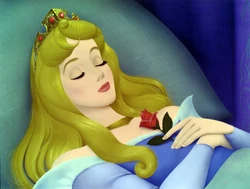
Princess Aurora, the titular character in Sleeping Beauty.
The fairies and Aurora return to the castle. Unfortunately, Maleficent uses her magic to lure Aurora away from her chamber and up into a tower, where an enchanted spinning wheel awaits her. The fairies go searching everywhere, trying to look for Aurora. But by Maleficent's order, Aurora touches the spindle by pricking her finger. When the fairies arrive in the same chamber where Aurora pricked her finger, they were too late. Maleficent taunts her arch enemies in their inability to defeat her. Right before their eyes, the evil witch uncovers the fallen princess and disappears, cackling in triumph. As had been foretold by the curse, she is put under a sleeping spell. Heartbroken about their failure to protect Aurora, the fairies place her on her bed with a red rose in her hand and cast a powerful sleeping spell on everyone in the kingdom, causing a deep sleep to fall over them until the fairies can find a way to break the curse. According to Hubert, who was about to go to sleep, they realize the answer is Phillip, but he has been kidnapped by Maleficent and her goons to prevent him from kissing Aurora and waking her up from the curse. The fairies sneak into Maleficent's lair, aid Phillip in escaping, and explain to him the story of Maleficent's curse. Armed with a magical sword and shield, he escapes, races to Stefan's castle, and battles Maleficent, who transformed herself into a gigantic fire-breathing dragon. After being cornered on a cliff, he flings the sword and it impales her heart, which kills her. He climbs into Aurora's chamber and removes the curse with a kiss. One by one, everyone else, including Stefan, Leah, and Hubert, awaken from their slumber.
As the film ends with Aurora and Phillip arriving in the ballroom, where the former is happily reunited with her parents, she then dances together with Phillip, each happy to learn that their betrothed and their beloved are one and the same, and Merryweather and Flora argue over the dress color again.
Cast
- Mary Costa as Aurora
- Bill Shirley as Prince Phillip
- Eleanor Audley as Maleficent
- Taylor Holmes as King Stefan
- Verna Felton as Flora and Queen Leah
- Barbara Jo Allen as Fauna
- Barbara Luddy as Merryweather
- Bill Thompson as King Hubert
- Bob Amsberry as Goon #1
- Candy Candido as Goon #2
- Pinto Colvig as Goon #3
- Hans Conried as the Royal Herald
- Clarence Nash as Samson
- Dallas McKennon as Owl, Diablo
- Marvin Miller as the Narrator
Production
Story development
Early Ideas
Imagination is the mold from which reality is created. Centuries ago, men of vivid imagination created the fairy tales which live to this day, even though in many cases the authors' names have been lost in the mist of antiquity. Of all these stirring legends of Princes and Princesses, of witches and fairies, and of the triumph of good over evil, none has ever been so inspirational to me as Sleeping Beauty.
—Walt Disney's interview for the film's original 1959 press book
In 1938, following the successful release of his first full-length animated feature Snow White and the Seven Dwarfs, Walt Disney began thinking about creating an animated adaptation of Charles Perrault's fairy tale La Belle au bois dormant, but, for reasons unknown, it didn't go any further than an idea stage back then. Twelve years later, in February 1950, another adaptation of Perrault's fairy tale, Cinderella, premiered and was a huge critical and commercial success, which, basically, marked the rebirth of Disney animation after the lean years of World War II, an era best known for cheaper package films, such as Saludos Amigos, The Three Caballeros, Make Mine Music, etc. Riding high on the success of Cinderella, Walt was determined to produce another feature based on a fairy tale, and, in November 1950, he officially announced he was developing Sleeping Beauty as an animated film. Disney envisioned this picture as his ultimate masterpiece, a film that he felt would be the pinnacle of his studio's achievements in the field of animation. At the same time, he realized, if his staff returned to the fairy tale format, they couldn't duplicate Snow White or Cinderella; it was necessary to develop new methods of storytelling to make Sleeping Beauty as special and as different as they could. As Walt told author Bob Thomas, "You've got a lot of elements to consider. For one thing, you fight to do something that breaks away from what we've done before. Sleeping Beauty was tough, because it had a lot of the elements that we had in Snow White and Cinderella. You've got to give the animators new things to work on to keep their enthusiasm up. All of a sudden in a meeting, one of them will say, "Haven't we don't this before?"—and we have, so we have to change it all over again..."
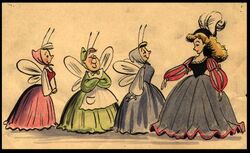
Early versions of the story indicated the names of the Three Good Fairies as Tranquility, Fernadell, and Merryweather (the latter, ultimately, remained in the final film).
After the production title was registered on January 19, 1950, Walt assigned a small team of Bill Peet, Ted Sears, and Winston Hibler to begin adapting Perrault's tale to the style of Disney feature. From the beginning of the writing process, the story artists decided to thoroughly rework the original story, deleting all the unnecessary elements, particularly, the "bizarre" second act of the fairy tale, and finding strength in the romance, for they felt little romance was developed between the strange prince and the princess. On May 15[1], 1951, the first outline was written, which featured a wake-up kiss as a climactic moment, as well as the meeting between the prince and princess before the latter falls asleep. Shortly before her sixteenth birthday, the princess, wishing to explore the world outside the castle walls, was to change the clothes with her maidservant and would have secretly escaped into the nearby forest, where she would have met and fell in love with the prince.[2] Then the prince would have gone on a journey to a faraway land and returned a few years later to find the princess and wake her up with his kiss. The outline also indicated the names of the fairies, the number of which was reduced from eight to four (three good and one evil), and their corresponding magical abilities: Tranquility, the Fairy of Dreams, Fernadell, the Fairy of Forest, Merryweather, the Fairy of Elements, and Maleficent, the Fairy of Darkness.

Early designs of Maleficent depicted her with a more inhuman, "insect-like" appearance.
Another challenge was to increase the conflict in the plot, so the story team decided to significantly expand the role of the evil fairy; it was also decided to make her a far more powerful and sinister character, the opposite of the depiction of the old hag in the original fairy tale. At this point of the story development, Maleficent was to conjure an indestructible spinning wheel, which the king and queen would have unsuccessfully tried to get rid of until, in desperation, they would have locked their daughter in the castle walls and not let her out. On the day of the princess' sixteen birthday, Maleficent, disguised as an elderly spinner, would have tricked her into pricking the finger with a spindle of the cursed spinning wheel, and then she would have surrounded the castle with an impenetrable wall of thorns. Maleficent was to engage in a fight with the prince at the climax, obstructing his passage with various hazards. At the same time, the story artists increased the role of the good fairies by turning them into comical companions and protectors of the princess, in the same way they did with the dwarfs in Snow White. The first outline and later versions included fairies' attempt to surround the castle with a protective circle, through which "no evil thing that walks, or flies, or crawls could ever pass", on the day of the princess' sixteenth birthday (it turned out to be unsuccessful, as Maleficent was able to enter the castle, disguising herself as a fish, caught by the pantry boy). The fairies were also to cast a sleeping spell on the castle when Maleficent's curse would have been fulfilled, and at the climax, they would have helped the prince overcome the hazards on his way through the thorn forest. Among other things, the plot introduced a talking vulture who was to become a comically incompetent "hench-bird" of Maleficent and would have tried to ingratiate himself with the animals of Fernadell to find out the information for his mistress (although early versions of the plot, including the first outline, depicted the evil fairy's hench-bird as a huge falcon, who was a far more sinister character).
Reworking
In June of 1952, Erdman Penner and Joe Rinaldi presented the final version of the story in the form of storyboard presentation, which left Walt dissatisfied as he felt that this story approach was way too similar to their past animated features, particularly Snow White and the Seven Dwarfs and Cinderella. Disney asked to rewrite the script, with the task of making their third princess as different from the previous heroines as possible. Walt also insisted that the writers should avoid the subplots, like the mice in Cinderella, and concentrate on the reality of the story and the subtlety of the main characters. At this point, the story team was joined by Joe Rinaldi, Ralph Wright, and Milt Banta.
The name of the lovely Sleeping Beauty is "Princess Aurora" (that means "sunrise" or "dawn" in Latin, Italian, Portuguese, and Spanish), in the film, as in Tchaikovsky's ballet; this name occurred in Perrault's version, not as the princess' name, but as her daughter's.[3] In hiding, she is called Briar Rose (from German Dornröschen, the name of the princess in the Brothers Grimm variant).[4] The prince was given the only princely name familiar to Americans in the 1950s: "Prince Phillip", named after Prince Philip, Duke of Edinburgh. The wicked fairy was aptly named Maleficent (which means "Evil-doer").
Princess Aurora's long, thin, willowy body shape was inspired by that of Audrey Hepburn. In addition, Walt Disney had suggested that all three fairies should look alike, but veteran animators Frank Thomas and Ollie Johnston contrasted this idea, saying that having them be like that wouldn't be exciting. Additionally, the idea originally included seven fairies instead of three.
Several story points for the film came from discarded ideas for Snow White and the Seven Dwarfs. They include Maleficent's capture of the Prince and the Prince's daring escape from her castle. Disney discarded these ideas from Snow White because his artists were not able to draw a human male believably enough at the time.
Walt Disney's absence
During the production of Sleeping Beauty Walt was busy with many other projects, such as the building of Disneyland, television shows, and live-action films, like 20,000 Leagues Under the Sea; therefore, he wasn't as involved in film's development as it was in the case with previous films. This resulted in constant changes in the film's release date, as well as the temporary delay of production that took place between 1954 and early 1956. Despite this, Disney was ultimately able to take part in the story's rewriting process, particularly, he personally reworked the scene where the Good Fairies decide they must rescue Phillip from Maleficent's domain so that it would have more emotion and impact (early storyboards for this scene show that it was originally to end with fairies finding Phillip's hat). Also, Walt personally cut out a good portion of humor, because he felt it would be more fitting for "Donald Duck shorts", rather than for feature film.
Art direction
The film holds a notable position in Disney animation as the last Disney feature to use hand-inked cels. Its art direction, which Walt Disney wanted to look like a living illustration, was not in the typical Disney style. Because WDFA had already made two features based on fairy tales - Snow White and the Seven Dwarfs and Cinderella, Walt decided this one to stand out from its predecessors by choosing a different visual style. The film eschewed the soft, rounded look of earlier Disney features for a more stylized one. Since Super Technirama 70 was used, it also meant the backgrounds could contain more detailed and complex artwork than ever used in an animated film before.
Disney artist Eyvind Earle was the film's production designer, and Disney gave him a significant amount of freedom in designing the settings and selecting colors for the film. He also painted the majority of the backgrounds himself. He took much of his inspiration from medieval art (particularly the millefleurs style of 15th-century tapestries), which tended toward a certain flatness and perspective lessened, most notably the French manuscript that was written by the Limbourg Brothers. The elaborate paintings usually took seven to ten days to paint; by contrast, a typical animation background took only one workday to complete. Disney's decision to give Earle so much artistic freedom was not popular among the Disney animators, who had until the film exercised some influence over the style of their characters and settings.
Character design and animation
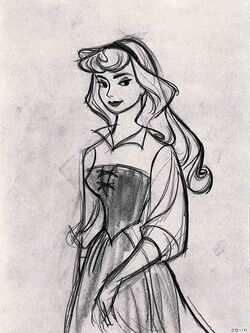
Tom Oreb was the first Disney artist to receive the credit of "character stylist", indicating his influence on the design of the characters.
Because of the artistic depth of Eyvind Earle's paintings, it was decided for the characters of to be stylized so they could appropriately match the backgrounds. While the layout artists and animators were impressed with Earle's paintings, they eventually grew depressed at working with a style that many of them regarded as "too cold, too flat, and too modernist" for a fairy tale feature. A major problem was that the backgrounds were so detailed and busy that it was hard for the animators to make the characters stand out and read against them. Eyvind's request to have the decision in the case of character designs and their color schemes was also met with a rather negative reaction from the animators, who always had a lot of input into the design and color modeling of their characters up to this point. On one occasion, a few of them went up to see Walt and to complain about it, but he didn't back them on this, for he wanted the visual design to carry the picture, while also claiming that the inspirational art he commissioned in the past had homogenized the animators. Tom Oreb was tasked as character stylist that would not only inhabit the style of Earle's backgrounds, but also fit with the contemporary UPA style; likewise with Earle's background styling, the animators complained that Oreb's character designs were too rigid to animate. Unlike the most of the animators, the studio's top draftsmen, Marc Davis and Milt Kahl, embraced Eyvind Earle's sophisticated style, what led to their appointment as supervising animators of the film's leading characters, Princess Aurora and Prince Phillip. Collaborating with Davis, Tom Oreb crafted a "leading lady of elegance", influenced by the features of Audrey Hepburn, who was a new film star at the time of Sleeping Beauty's production. He incorporated the strong horizontal and vertical lines of the backgrounds into Aurora's design, while Marc slightly sharpened her features and clothes to blend with the settings' angular shapes, as well as added Art Nouveau and Art Deco into her hair. The final design, that perfectly complemented Earle's backgrounds, was "more refined" than those of preceding Disney heroines, and thus required much more attention to detail than any animated character before. Quality control animator Iwao Takamoto, who also was Marc Davis' assistant during the film's production, described working with refined drawings of Aurora as a "laborious job", and ultimately limited in-betweeners such as himself to completing only seven drawings per day.
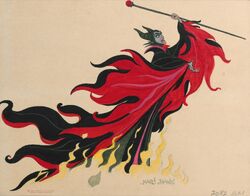
In designing Maleficent, Marc Davis experimented with flamelike shapes and patterns of triangular color.
Marc Davis was also selected to supervise the design and animation of Maleficent and, by extension, her pet raven, Diablo. He decided to move on from the early suggestions for the character's design, that included more inhuman, "insect-like" elements, in favor of a more ominous figure, of whom he thought as a "giant vampire bat". Davis' primary inspiration was a religious painting from a Czechoslovakian art book he found in his home library, featuring a figure with the flame-like drapery that he thought would be great to use. He also added the horns and material, based on the bat's wings, around Maleficent's face to achieve what he called a "devil image", while her costume was endowed with a reptilian quality, foreshadowing the dragon into which she would transform at the film's climax. Marc's original designs featured red trim to Maleficent's robe to highlight its flame-like shape, but, in an act of artistic compromise, Eyvind Earle requested the change to lavender as red would come off too strong, in which Davis agreed to. Frank Thomas and Ollie Johnston, who, on contrary to Davis and Kahl, struggled the most to adapt to Earle's style, were given the task of designing and animating Flora, Fauna, and Merryweather. At first, Walt considered making the fairies identical, similarly to Huey, Dewey, and Louie, but Frank and Ollie felt that such an approach wouldn't be half as much fun, so they had to do a lot of talking to convince Walt to give the characters more distinctive looks and personalities. Ultimately, they also managed to reach the artistic compromise with Earle: the fairies received the required angularity in their costumes, based on geometrical shapes, but retained a "warm, round, cuddly" feel, akin to the previous Disney characters, with their facial features.
Live-action reference
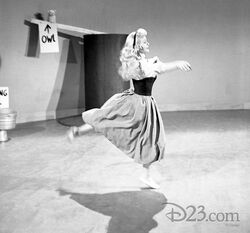
Helene Stanley provides the reference of Briar Rose's dance for "Once Upon a Dream" scene.
Before the animation process began, a live-action reference version was filmed with live actors in costume serving as models for the animators. This was an important requirement of Walt, who wanted the animators to make the characters "as real as possible, near flesh and blood"; however, Milt Kahl objected to this method, considering it "a crutch, a stifling of the creative effort" and claiming that "anyone worth his salt in this business ought to know how people move." Helene Stanley, who previously provided the live-action reference for the title character in Cinderella, was hired as a model for Aurora. As a part of the reference, she played in a blond wig and costumes specially designed by Alice Estes at the behest of Marc Davis, then a student of the animator at Chouinard Art Institute. The only known surviving footage of Stanley as Aurora's live-action reference is a clip from the television program Disneyland, which consists of the artists sketching her dancing with the woodland animals. Stanley also provided a reference for some scenes of Merryweather. The role of Prince Phillip was modeled by Ed Kemmer, who had played Commander Buzz Corry on the then-popular television show Space Patrol. For the final battle sequence, Kemmer was photographed on a wooden buck. Cubby O'Brien, then a Mouseketeer of the Mickey Mouse Club, provided the reference for Phillip as a child. In addition to the voice acting, Eleanor Audley served as a model for Maleficent; occasionally she was replaced by Jane Fowler, who also provided the reference for Queen Leah. Among the actresses who performed in reference footage as the Three Good Fairies included Spring Byington, Frances Bavier ("Aunt Bea" from The Andy Griffith Show) and Madge Blake; the voice actresses didn't fit for they weren't "pudgy" enough. The role of King Stefan was modeled by Hans Conried, who had previously voiced and modeled both Captain Hook and George Darling in Peter Pan. Conried's companion in the role of Mr. Smee, Don Barclay, served as a model for King Hubert. Sir Minstrel, who serves wine to the kings in the "Skumps" sequence, was modeled by Franklin Pangborn.
Reception
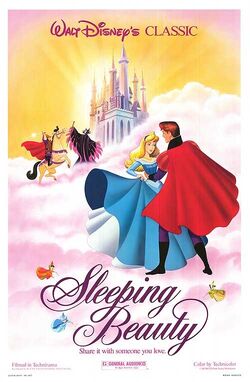
1986's re-release poster.
During its original release in 1959, the film earned approximately $5.3 million in box office rentals. Its production costs, which totaled $6 million, made it the most expensive Disney film up to that point, and over twice as expensive as each of the preceding three Disney animated features: Alice in Wonderland, Peter Pan, and Lady and the Tramp. Its high production costs, coupled with the underperformance of much of the rest of Disney's 1959–1960 release slate resulted in the company posting its first annual loss in a decade for the fiscal year 1960, and massive layoffs were done throughout the animation department.
The film was met with mixed reviews from critics, often citing the film being slowly paced and having little character development. Nevertheless, it has sustained a strong following and is today hailed as one of the best-animated films ever made, thanks to its stylized designs by painter Eyvind Earle who also was the art director for it, its lush music score, and its large-format 70 mm widescreen and stereophonic sound presentation.
Rotten Tomatoes gives the film a "Certified Fresh" 89% from 46 reviews with an average rating of 8.2/10. Its consensus states that "This Disney dreamscape contains moments of grandeur, with its lush colors, magical air, one of the most menacing villains in the Disney canon."
Like Alice in Wonderland, which was not initially successful either, the film was never re-released theatrically in Walt Disney's lifetime. However, it had many re-releases in theaters over the decades. It was re-released theatrically in 1970, 1979 (in 70 mm 6 channel stereo, as well as in 35 mm stereo and mono), 1986 and 1995. A 1993 re-release was planned, as it was promoted on the 1992 VHS of Beauty and the Beast, but it was canceled. Its successful reissues have made it the second most successful on release in 1959, second to Ben-Hur, with a lifetime gross of $51.6 million. When adjusted for ticket price inflation, the domestic total gross comes out to $478.22 million, placing it in the top 40 of films.
Release
Disney's distribution arm, Buena Vista Distribution, originally released the film to theaters in both standard 35 mm prints and large-format 70 mm prints. The Super Technirama 70 prints were equipped with six-track stereophonic sound; some CinemaScope-compatible 35 mm Technirama prints were released in four-track stereo, and others had monaural soundtracks. On the initial run, it was paired with the short musical/documentary film Grand Canyon which won an Academy Award.
Worldwide release dates
- Argentina: July 9, 1959
- United Kingdom: July 29, 1959
- Germany: October 30, 1959 (West); October 10, 1969 (East)
- Italy: December 1, 1959
- France: December 16, 1959
- Netherlands: December 17, 1959 (English version); April 14, 1960 (Dutch version)
- Finland: December 18, 1959
- Ireland: December 18, 1959
- Sweden: December 19, 1959
- Australia: December 24, 1959
- Mexico: December 24, 1959
- Denmark: December 26, 1959
- Norway: December 26, 1959
- Hong Kong: May 26, 1960
- Japan: July 23, 1960 (distributed by RKO Pictures Japan)
- Spain: October 3, 1960 (Madrid)
- Brazil: December 22, 1960
- Portugal: April 2, 1961
- Poland: 1962
- Turkey: April 23, 1962
- Hungary: June 30, 1966
- Kuwait: May 24, 1999
Home Video
- Main article: Sleeping Beauty (video)
In 1986, the film was first released on both VHS and Laserdisc under the Classics collection, becoming the first Disney Classics video to be digitally processed in Hi-Fi stereo. Then it underwent an extensive digital restoration in 1997, and that version was released on both VHS and Laserdisc again (this time with the Laserdisc in widescreen version, albeit letterboxed) as part of the Masterpiece collection, and in 2003 was released to DVD in a 2-disc "Special Edition" that included both the original widescreen version and a pan and scan version as well. A Platinum Edition DVD/Blu-ray Disc was released on October 7, 2008 with a never-before-seen 2.55:1 expanded version of the film. The DVD/Blu-ray returned to the Disney Vault in 2010. It was released as a Diamond Edition title on October 7, 2014, and on September 24, 2019, it was re-released as an Anniversary Edition as part of the Signature Collection.
Videos
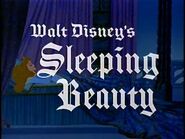
Sleeping Beauty - Original Theatrical Teaser Trailer
1959 Original Teaser Trailer
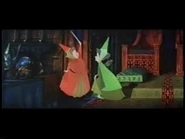
Sleeping Beauty Official Trailer-2
1959 Original Theatrical Trailer
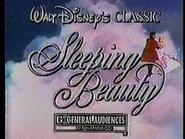
Sleeping Beauty TV trailer 1986-2
1986 Reissue Trailer
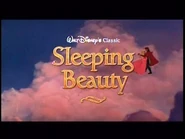
Sleeping Beauty - 1995 Reissue Trailer-2
1995 Reissue Trailer
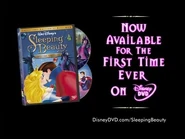
Sleeping Beauty - Special Edition 2003 Trailer-2
2003 Special Edition Trailer

The Making of Sleeping Beauty-0

Sleeping Beauty Platinum Edition Blu-Ray DVD Trailer
2008 Platinum Edition Trailer

Sleeping Beauty Official Diamond Edition Blu-Ray Trailer -1 (2014) Disney Movie HD-2
2014 Diamond Edition Trailer
Gallery

Trivia
- The film's copyright was renewed on June 12, 1986.[5]
- "Briar Rose" is another name given to the character, and appears in the German version of the Brothers Grimm as Dornröschen.
- Some artists who worked on this film came back to Disney in 1988-89 to work on Oliver & Company, The Little Mermaid, and The Rescuers Down Under. These artists included Don Selders (Assistant Animator), Eve Fletcher (Ink & Paint Artist), Ann Oliphant (Animation Checking), Darlene Kanagy (Ink & Paint), Gordon Bellamy (Assistant Animator), Tom Ferriter (Assistant Animator), Eleanor Dahlen (Ink and Paint), Sheila Brown (Assistant Animator), and Valentine Vreeland Paul (Ink and Paint Artist).
- Maleficent's curse can be fulfilled at any time before sunset on Aurora's sixteenth birthday.
- Aurora is one of the seven Princesses of Heart in the popular Disney/Squaresoft game Kingdom Hearts, and Maleficent is a villain in all three Kingdom Hearts games. The good fairies appear in Kingdom Hearts II, giving Sora new clothes.
- The character of Aurora's mother, the Queen, has no name credited to her. The only version of the story which gives her a name is a 1993 adaptation by A.L. Singer, in which she is named Queen Leah.
- The cry voiced by Lucille La Verne as The Evil Queen in Snow White and the Seven Dwarfs was re-used for Maleficent when her dragon-form is pierced by Prince Phillip's sword.
- Rich Animation Studio's 1994 animated film The Swan Princess was quite similar to this film. In that film, it also had a princess named Odette being cursed by an evil enchanter named Rothbart, just as Maleficent cursed Aurora. During the climax near the end of that film, Odette died temporarily as Aurora fell into a deep sleep and a prince named Derek saved her by killing Rothbart, who had turned himself into the Great Animal, just as Maleficent transformed herself into a dragon and Prince Phillip killed her and saved Aurora with "True Love's Kiss". Interestingly, though the story is also based on Tchaikovsky's ballet (Swan Lake), the filmmakers chose not to adapt the ballet score. Instead, they went with a generic '90's pop score by Lex de Azevedo, the score composer for the film and for the first two sequels of the Swan Princess franchise; The Swan Princess: Escape from Castle Mountain and The Swan Princess: The Mystery of the Enchanted Treasure.
- Hidden Mickey: The biscuits the fairies eat with tea are shaped like Mickey Mouse's head and ears.
- The film was made whilst Walt Disney was building Disneyland (hence the four-year production time). To help promote the film, Imagineers declared the castle there to be Sleeping Beauty's (it was originally to be Snow White's).
- Second only to Dumbo (who didn't speak at all), this Disney title character has the fewest lines of actual dialogue throughout the entire film.
- In fact, Aurora and Philip say nothing at all in the film's second half, even after the sleeping spell is lifted.
- The musical score throughout the film was provided by the then Graunke Symphony Orchestra (since 1990 called the Munich Symphony Orchestra), under the direction of the score's adapter, George Bruns.
- The particular melody that plays as Phillip and Aurora descend the stairs toward the film's end was a branle couppé (a short, vigorous country dance) entitled "Cassandre" written by Renaissance composer Thoinot Arbeau, adapted ca. 1590 as a march in honor of King Henri IV of France, and used as something of a national anthem by French royalists; Tchaikovsky, who had a fondness for national anthems, incorporated it into his ballet score to represent the royal court of "Florestan XIV".
- The complex and detailed background paintings, most of which were done by Frank Armitage and Eyvind Earle, usually took seven to ten times longer to paint than average, which takes about a workday to complete. As opposed to having the backgrounds be designed to match the characters, the film's characters were designed to match the backgrounds.
- The film is the only Disney film with square trees.
- The debate on the setting of this film has been a problem for a long time.
- The moment where Aurora pricks her finger, as well as the fight of Prince Phillip with Maleficent, are referenced in the Nightwish song "Fantasmic", with the lyrics "Maleficent's fury/The spindle so luring/Dragon fight."
- Upon release, the scene where Prince Phillip encounters the dragon was thought too intense for young viewers.
- The original concept for the film began in 1950 (after the studio had animated two other princess fairy tales). Work on it was delayed because Walt Disney's attention was turned to the building of Disneyland.
- Walt Disney had originally envisioned the film as his masterpiece.
- On the Blu-ray releases beginning with the 2008 Platinum Edition release, the film is in 2.55:1 widescreen, unlike its previous home video releases (especially the 1997 laserdisc and the 2003 Special Edition DVD which had 2.20:1 widescreen aspect ratio). Showing more picture on the sides.
- Because the film was such a box office disappointment, Disney focused more on live-action films for two years (there were ten before Disney released another animated feature: 101 Dalmatians. The style of animation in this one was radically different, possibly because it had been such a failure).
- The film was in the archive for seven years.
- The film appears as one of the transition levels in Epic Mickey, found in Dark Beauty Castle.
- The film is the first Disney animated classic to have the 2006 Walt Disney Pictures logo at the end of current releases.
- The studios have no record as to who provided the voices for the Queen, nor the Royal Herald.
- Barbara Jo Allen (Fauna) was also known as Vera Vague in some of her other films and for her last film role as the Scullery Maid in The Sword in the Stone.
- A flamethrower was used to create the dragon breath sound effect for the climax of the film, with training films supplied by the US Army.
- Barbara Luddy (Merryweather) lent her voice to Lady in the earlier Disney film, Lady and the Tramp. After this one, she would also end up being the voices of Mother Rabbit in Robin Hood and Kanga in The Many Adventures of Winnie the Pooh for her final film.
- Eleanor Audley, (Maleficent), also provided the voice of Lady Tremaine in Cinderella nine years earlier.
- Before Taylor Holmes was chosen as the final voice of King Stefan in the final version of the film, Hans Conried was considered to voice Stefan as he provided some voice lines for Stefan that can only be heard in the demo soundtrack, after lending the voices and modeled for both Captain Hook and Mr. Darling in Peter Pan.
- Similary, before Hans Conried was supposedly recast as the herald while being replaced by Taylor Holmes for Stefan's voice role in the film's final cut, it can possibly be noted that Bill Scott was initially considered to voice the herald as he recorded two voice lines that can only be heard in The Legacy Collection: Sleeping Beauty.
- Verna Felton (Flora and the Queen) previously lent her voice to the Elephant Matriarch and Mrs. Jumbo in Dumbo, the Fairy Godmother in Cinderella, the Queen of Hearts in Alice in Wonderland, and Aunt Sarah in Lady and the Tramp. After this one, her last film for Disney and for her acting career was providing the voice for Winifred in The Jungle Book.
- Maleficent's horned headdress and bat's-wing-like sleeves, besides being reminiscent of the popular images of horned devils and dragons, reflect actual women's costumes of the fourteenth century.
- The animators couldn't decide what dress color Aurora should wear, so they decided to make it part of the storyline with the fairies.
- In the opening previews of the 1997 VHS re-released under the Walt Disney Masterpiece Collection line, there was a commercial for Disney's Magic Artist on CD-ROM.
- As filmed, the plot bears a remarkable resemblance to that of the novel and lost silent film The Goose Girl except that there is only one girl involved going by two different names.
- When Rose gets her crown from the fairies, she begins crying still wanting to see Prince Phillip, but it's actually not her crying from her voice actress, it's actually Dopey's crying that's reused from Snow White and the Seven Dwarfs.
References in other media
- The film was referenced in Dan Brown's The Da Vinci Code as an allegory of the Grail quest.
- The music for the film was adapted by Disney's musical director George Bruns from Tchaikovsky's ballet La belle dormant au bois (literally, "The Beauty Sleeping in a Wood"), for which he was nominated for an Academy Award.
- The two songs "I Wonder" and "Once Upon a Dream" are based on "The Garland Waltz" from Tchaikovsky's ballet. It was also used in recent commercials for Sargento Cheese, as well as a couple of Fred Quimby era Tom & Jerry cartoons.
- The sleeping spell was spoofed on Hanna-Barbera's The 13 Ghosts of Scooby-Doo in 1985 in which Scooby-Doo must save Daphne Blake and Princess Esmerelda from this spell caused by Maldor the Malevolent. Interestingly, in the episode from What's New Scooby-Doo?, Daphne wore an outfit similar to one of Aurora's.
References
- ↑ The 1951 Outline feature from Special Edition DVD also indicates April 1951 as a date of outline's writing.
- ↑ In later versions of the story, the place of meeting between the prince and princess was rewritten as a country fair.
- ↑ Heidi Anne Heiner, "The Annotated Sleeping Beauty"
- ↑ Jacob and Wilhelm Grimm, Children's and Household-Stories, "Briar Rose"
- ↑ Online Copyright Catalog search (form autofilled, pressing "begin search" brings up the entry)
External links
| v - e - d | ||||||||
|---|---|---|---|---|---|---|---|---|
|
| v - e - d | ||||||||||||
|---|---|---|---|---|---|---|---|---|---|---|---|---|
|
| v - e - d | ||||||||||||||
|---|---|---|---|---|---|---|---|---|---|---|---|---|---|---|
|
Sleeping Beauty Cartoon 70s Movie Not Disney
Source: https://disney.fandom.com/wiki/Sleeping_Beauty

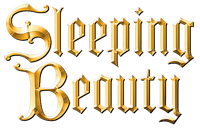

0 Response to "Sleeping Beauty Cartoon 70s Movie Not Disney"
Post a Comment